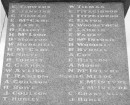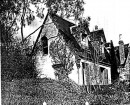MALMSBURY COMMON MINING COMPLEX AND RIFLE RANGE
90 MOLLISON STREET MALMSBURY, MACEDON RANGES SHIRE
-
Add to tour
You must log in to do that.
-
Share
-
Shortlist place
You must log in to do that.
- Download report
Statement of Significance
This record has minimal details. Please look to the right-hand-side bar for any further details about this record.
-
-
MALMSBURY COMMON MINING COMPLEX AND RIFLE RANGE - History
Malmsbury Common Mining Complex and Rifle Range History; by H. Kiddell 2009.
GOLD ERASoon after Hoddle's announcement that Malmsbury would be laid out by surveyor Urquhart, the course of the township's history was set on a new trajectory by the discovery of gold in the (newly independent) colony. A man named Hiscock discovered gold at Buninyong in the first week of August 1851, which was followed by a more significant find at Ballarat. By November that year the Mount Alexander goldfields were in full swing (Annear 1999:10.12). Malmsbury was situated on the main road to Mount Alexander and consequently developed as a stopover rest spot on the well-trodden route to the goldfields.
James Flett, who has compiled an extensive study on the discoveries of gold across Victoria, states that gold was first struck near Malmsbury at Lauriston in November 1851 (Flett 1970:202). Local historian Roslyn Stevens states that the first gold discovery at Malmsbury was in April 1858 on the river flats, and that by 1865 there were 26 mining companies working at Malmsbury and Lauriston (Stevens 1974:8). A map of the Malmsbury and Lauriston goldfields published by the government in 1896 clearly shows that the Coliban River running alongside the activity area was worked for gold.
The second edition of the map published in 1906 illustrates the goldworkings along the river, indicated by red dots, and shows the location of the Burra shaft which is within the activity area (Figure 1).
Figure 1: Detail: Molmsbury and Lauriston Goldfields, 1906, SLV MAPS (see attachment).The Burra Mine was most productive during the 1860s and 1870s (Bannear, 1993). David Bannear (1993) conducted a study of historic mining sites in the Taradale Mining Division and included the Burra Mine site in his investigation. He described the site of the Burra reef workings as being heavily overgrown with gorse and high grass, with no machinery footings visible. He noted that there were some small mullock dumps and that there were workings on both sides of the Coli ban River (Bannear 1993: part 2, 18). Mining surveyors' reports from July 1863 stated that "some very rich quartz has lately been raised and crushed from the prospectors' claim on the BUrra Burra' (ibid.). In 1872 reports noted that the BUrra-Burra Quartz Gold Mining Company had recently "struck very good stone at about 40 feet deep" (ibid). Bannear classified the Burra mine site to be of low cultural significance, as it had "little integrity or historical importance" (ibid.).
Despite having some goldmining activity Malmsbury developed more as a result of the passingtrade.
A map from 1860 illustrating the 'Mining District of Castlemaine', shows that Malmsbury was not a centre of activity, compared to nearby Fryer's Creek which was cluttered with named gold fields (PROV: GF 72).
The proximity of the goldfields benefited Malmsbury with the provision of services, including the railway which went through to Sandhurst (Bendigo) and onwards to Echuca. In April 1862 the railway line reached Kyneton and in October that year the line was opened through to Sandhurst (Lee 2007:46). The bluestone bridge over the Coli ban at Malmsbury, south of the activity area, is a fine example of nineteenth century railway engineering and is a five-span segmented arch construction (VHR: H1434).
Another major engineering project to impact Malmsbury, although it took longer to implement than the railway, was the Coliban Water Scheme. The Coli ban Scheme was conceived to provide water to the goldfields at Sandhurst and Castlemaine (Mount Alexander). It required the construction of two reservoirs on the Coliban River and a line of aqueduct to convey the water to the drought-ravaged goldfields (Russell 2009:139). The site of the Malmsbury Reservoir was chosen by 186S and on 12 June 1866 the construction of the reservoir officially commenced with the turning of the first sod by the Mayor of Malmsbury in front of 100 guests (Russell 2009:139-144). Thomas Greenwood and Co.
won the tender to complete the works. Such a large project brought immense benefits to the local Malmsbury economy, as men lined up for work and the town was transformed into a 'great state of bustle' (Russell 2009:143). The project did not proceed all that smoothly and was subject to delays and fears the scheme might never be realised. However in November 1877 the Coli ban System of Waterworks was completed and assured Bendigo and Castlemaine of permanent supply of water (Russell 2009:xii).
QUARRYINGA map produced for the Geological Survey of Victoria in 1865 describes the activity area as being composed of "6ft of brown sandy clay used for brickmaking, covering 4-6 [foot) quartz gravel" (http://nla.gov.au/nla.map-rm233S-18-sd-cd). It is quite likely that this brickmaking clay was exploited, considering that the town was going through a rapid growth period.
The stone quarries were generally situated to the north-eastern corner of the town. In 1870 enough stone for 3.000 yards of paving was sent to Melbourne from Malmsbury (Stevens 1974:11). In 1874 the Malmsbury Stone Cutting Company commenced operations on Mollison St, between the river and the race (ibid.).
A section of the Coliban River within the activity area has also been subject to some quarrying activity along its banks, although it was not bluestone that was extracted. A letter from the Town Clerk's Office on the 23'" of November 1893 was addressed to the Secretary for Lands department and requested authorisation "to remove gravel, loam etc from the banks of the Coliban River in the Township, for use on the footpaths and roads within this municipality" (VPRS 242/164/74240).
A further clarification dated 2" of February 1894 states that the "portion on the Coliban the Malmsbury borough Council ask to remove the gravel, loam etc. from extends North from the Bridge over the river in Mollison St as far as the old Rifle Buffs, a distance of about twenty chains" (ibid.).MALMSBURY COMMON
In 1879, 28 acres of land bounded by the Clarendon Place in the west and the Coli ban River in the east was reserved as a site for "Volunteer Rifle Practise and Drill Ground". The notice withholding the land "from sale, leasing and licensing" appeared in the Victorian Government Gazette on Friday, 1" August 1879. The rifle range site, or allotment 7, section B Parish of Edgecombe, was later purchased by the Commonwealth of Australia on the 1" of March 1901.
Roslyn Stevens rela tes that the Malmsbury Volunteers were known as the "Castlemaine Grays".
They held rifle practise weekly, and their target stood by the river "near the Burra Burra mine" at the northern section of the activi ty area. Stevens does not put a date on when the Volunteers were active, but does relate an incident when some of the group went off after a rumour of the Kelly Gang being in the area. A letter from the Town Clerk's Office dated the 5" of June 1915 and addressed to the Secretary of the Defence Departm ent is a response to an advertisement inviting tenders for the right to graze the Rifle Range Reserve at Malmsbury. The town clerk on behalf of the Council requested in his letter that the Defence Department should not lease out the Reserve, and instead let it IIremain as it is at present". The letter provides clear detail on how the activity area was used at that time:"The Reserve in question has never been fenced, and is the only portion of the original Common left to the Ratepayers, and the council has expended a considerable sum from time to time in planting trees on both sides of the River. The whole length of the fron tage facing the Reserve, the River at this spot, has been placed by the State Rivers and Water Supply Commission under the control of the Council for a Public bathing place.
As one of the beauty spots of the town it is greatly availed of for picnics and camping purposes, there being a water reserve on it, from which trovelling stock and those of the residents of the borough are watered. There is Rifle practise on the Range each Saturday, and often on other days during the week." (VPRS 11998/1 "Malmsbury Committee Minutes Book" letter inserted loose into book).
In the early 1930s the range was still being used as a grazing area for the town's stock. There was some confusion about the boundaries of the Malmsbury Common, which had initially been proclaimed in the Gazette of 1862 (GG 139, 1862:2484). The proclamation creating the Malmsbury Municipal Common simply included "all the unappropriated Crown lands within the municipal boundaries of Malmsbury containing 307 acres, more or less" (ibid.) Therefore in 1932 the Shire Secretary found it difficult to ascertain how much income was being derived from grazing on the Common. He ex(plained to the Secretary of l ands in Melbourne in answer to an inquiry that the Council leased the Rifle Range from the Defence Department and stated: "this is now (and indeed has always been) the chief grazing area" (VPRS 242/249/69743).
A topographic map of the area published by the Department of Lands and Survey in 1948 does not illustrate a rifle range on the Common, but does show that there was no other development on the site either (SLV Maps 1948) In May 1967 the Crown granted Allotment 7 Section B back to the "President, Councillors and Ratepayers of the Shire of Kyneton". Allotment 1 Section C, across the river from the ac tivity area was also granted to the Shire at the same time. When a review of the boundaries of the Malmsbury Municipal Common was cond ucted in 1971 only one allotment in Malmsbury was found to be still part of the Common, along with one allotment in Lauriston. After the review only one allotment remained officially part of the Common.
Presently, the township of Malmsbury, including the activity area, is recognised as a historical precinct and is covered by a Heritage Overlay under the Macedon Ranges Shire Planning Scheme (HO 148 - Malmsbury Precinct).
MALMSBURY COMMON MINING COMPLEX AND RIFLE RANGE - Interpretation of Site
The site comprises a landscape that was used extensively for gold mining from 1851-1870s.
In 1879, 28 acres of land was reserved for a "Volunteer Rifle Practise and Drill Ground". A rifle butt still remains on site today and historical evidence indicates that the grounds were still used for rifle practise in 1915.
Quarrying for clay and quartz gravel was conducted in parts of the site (along the Coli ban River) from c1865 to c1894. In the early 20th century the townspeople used the area for stock grazing (until the early 1930s). In 1967 the current area that comprises "Malmsbury Common" was granted to the town and townspeople as a common use area. Today it is recognised as a historical precinct, and is open for use by the public for recreational activities
MALMSBURY COMMON MINING COMPLEX AND RIFLE RANGE - Archaeological Significance
The archaeological significance of the site is moderate. This is based on the high potential for archaeological deposits to be present that may provide scientific information on the use of the area during the gold rush and subsequent uses by the local community.
The preservation of the site is high, as little significant ground disturbing works have occurred on the site since the time of gold mining (with the exception of quarrying, which has impacted some sections of the site, near the Coliban River).
The use of the site for rifle practise with a remaining rifle butt, thought to be constructed in 1879, is a rare feature and this increases the archaeological significance of the site.
MALMSBURY COMMON MINING COMPLEX AND RIFLE RANGE - Historical Significance
Malmsbury Common is historically significant for associations with gold mining in the mid 19th Century, local community rifle group from late 19th Century to early 20th Century; and long-term use as public land for the local community.
Heritage Inventory Description
MALMSBURY COMMON MINING COMPLEX AND RIFLE RANGE - Heritage Inventory Description
The site comprises partial blue stone and brick wall associated with a quartz crusher from gold mining and multiple pits (some with remnant dressed blue stone) across the landscape associated with alluvial gold mining. Gold mining in this area was conducted primarily between 1851 -1870s.
In 1879 a volunteer rifle group established a rifle butt in the northern section of the site, which still remains today.
-
-
-
-
-
MALMSBURY RAILWAY VIADUCT
 Victorian Heritage Register H1434
Victorian Heritage Register H1434 -
MALMSBURY RAILWAY STATION
 Victorian Heritage Register H1574
Victorian Heritage Register H1574 -
MALMSBURY BOTANIC GARDENS AND TOWN HALL
 Victorian Heritage Register H1993
Victorian Heritage Register H1993
-
-









